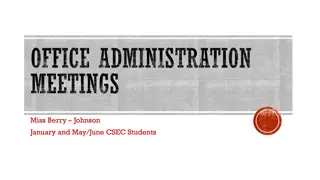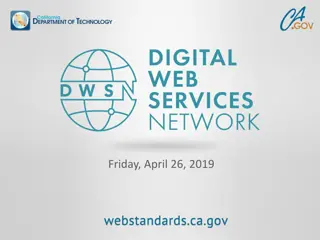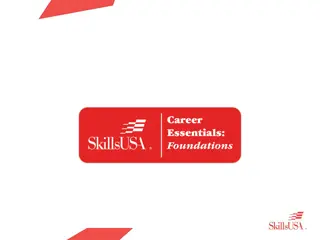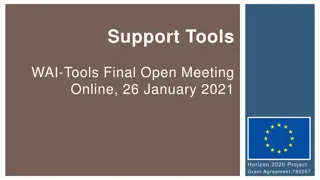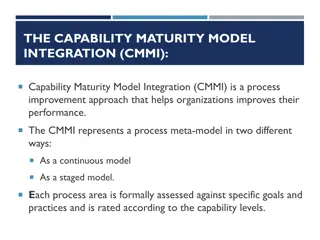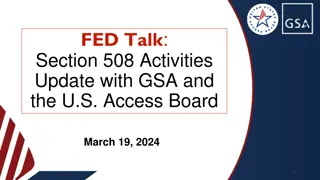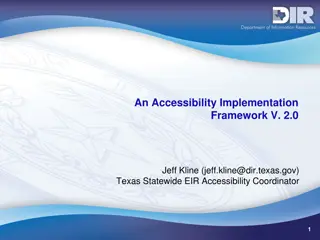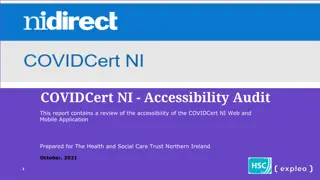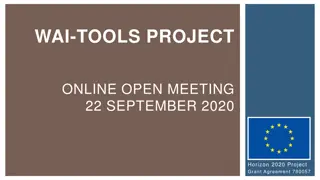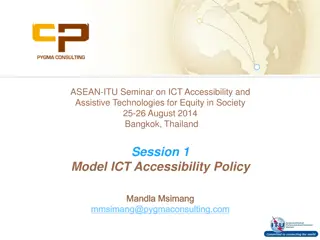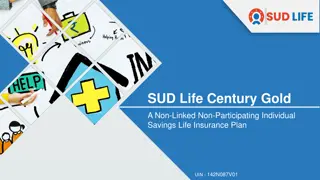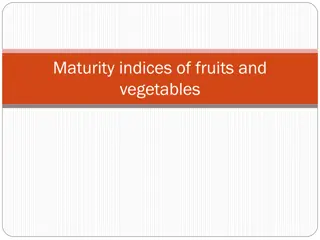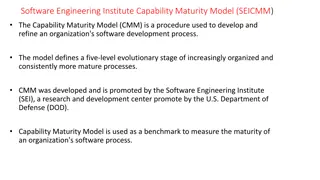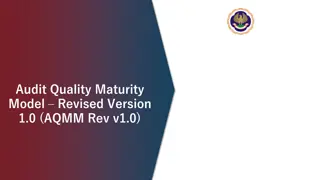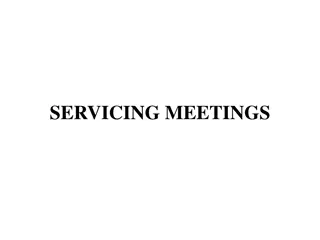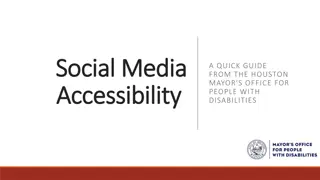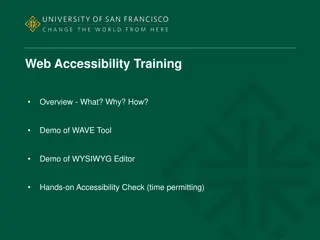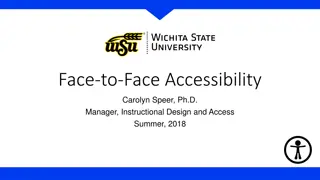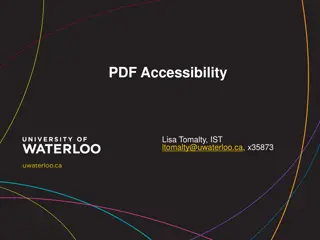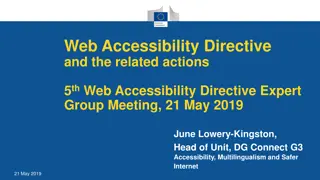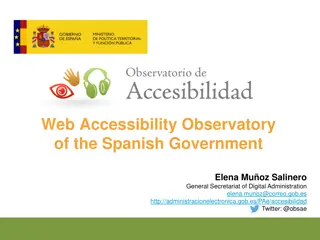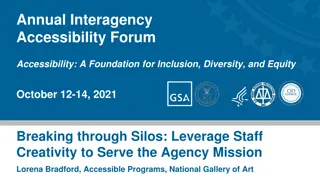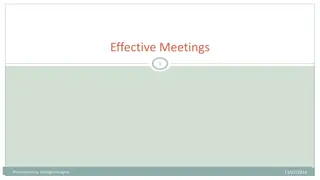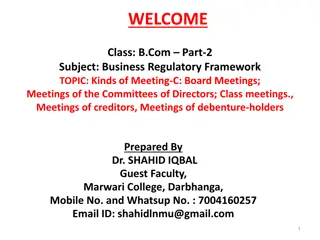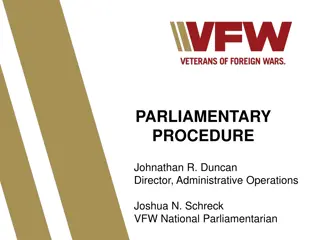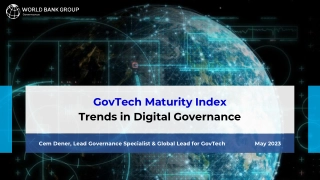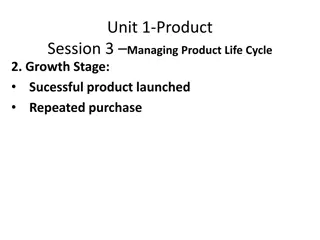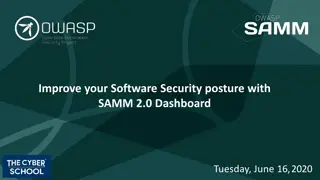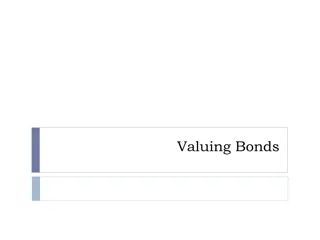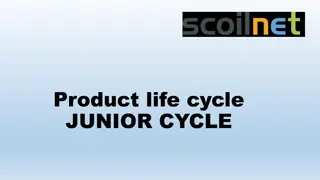Leveraging Maturity Models in Accessibility Community Meetings
Explore the importance of maturity models in assessing effectiveness and capabilities for improvement in the realm of accessibility. Delve into topics like defining success, standing up a 508 Office, and understanding OMB 508 Maturity Model. Discover how maturity models can enhance understanding and drive continuous improvement.
Download Presentation

Please find below an Image/Link to download the presentation.
The content on the website is provided AS IS for your information and personal use only. It may not be sold, licensed, or shared on other websites without obtaining consent from the author. Download presentation by click this link. If you encounter any issues during the download, it is possible that the publisher has removed the file from their server.
E N D
Presentation Transcript
Accessibility Community Meeting Topic 1: Link & Leverage Harnessing the power of maturity models
Meet your presenter US Department of Labor Branch Chief of IT Quality Management Office of the CIO Approximately 18,000 employees nationwide 27 mission Agencies of various sizes 450 offices across the US & its territories
Background Started my career in the automotive industry Went from manufacturing to IT procurement and Indirect Materials Management Joined DOL in December of 2009 as a COR Held several leadership positions, ending with Quality Management Asked to stand up a Section 508 Program Office
How do you stand up a 508 Office? Deputy Secretary mandated creation of a Section 508 Program Office DepSec did not define success CIO did not define success I was given 2 weeks to define success The GSA 508 Playbook was thorough but not appropriate DOL was already hitting multiple plays Filling in the blanks wasn t a reasonable approach
Intro to Maturity Models Maturity Models are tools to help assess your current effectiveness and determine capabilities necessary to improve. Structure of a typical Maturity Model: 1. Initial or Ad Hoc Level: just beginning to work in the area but uncoordinated 2. Repeatable Level: developing skill and can achieve acceptable outcomes regularly 3. Defined Level: implementing standard processes and a structured approach 4. Managed Level: measuring the work and using the results to detect and correct errors 5. Optimizing Level: has standardized processes, defined service levels and metrics, and is using data to drive continuous process improvements
The OMB 508 Maturity Model The OMB Section 508 Maturity Model only has four levels: 1. Ad Hoc: No formal policies, processes, or procedures defined. 2. Planned: Policies, process, and procedures defined and communicated. 3. Resourced: Resources committed and/or staff trained to implement policies, processes, and procedures. 4. Measured: Validation is performed; results are measured and tracked.
The Power of Maturity Models Maturity Models help us frame our work so people understand Maturity Models help us focus on vision, strategy, and effective goals OMB Maturity Model provides Domains that help target improvement efforts 1. Acquisitions 2. Tech Lifecycle 3. Testing & Validation 4. Complaint Management 5. Training
Project: Getting to Measured Proposed a 9-month Get to Measured project We would not be complaint but we d have the foundation for more rapid ongoing improvements DOL leadership understood the accessibility requires ongoing effort I was provided minimal resources for the project: One part-time Project Manager 1.5 Section 508 Subject Matter Experts
Questions? Comments? (Snide Remarks?)
Accessibility Community Meeting Topic 2: Build a Foundation Completing the Get to Measured Project
Get the Lay of the Land Allocated 3 months for discovery with our 27 DOL Agencies and looked at the info through two lenses : Five Domains of the OMB Section 508 Maturity Model DOL Leadership s lens Software & Applications, Websites, and Documents With the Leadership Lens, we linked every Agency to accessibility They create thousands of documents a week Approximately 4 million documents are in various repositories Agency Leadership still pushes for us to do remediation
Determine Your End State Completed the discovery phase and then defined our end state OMB s definition of measured is vague: Validation is performed; results are measured and tracked. We had to define what we would consider measured : Had lots of healthy debate Considered the current state Considered the timeframe we had to work with
Conduct Your Gap Analysis Final step was to conduct a gap analysis and understand what was missing in each Domain. Build on what came before: Acquisitions example: Ensure policies and processes were defined and communicated, that staff were trained to implement them, and that we were performing validation and tracking results. We identified the gaps within the levels of maturity for each Domain. This allowed us to determine what work needed to be done.
Run it Like a Project We created our work breakdown structure (WBS) and broke it down into actual tasks Assigned the tasks and set our schedule Having an experienced Project Manager was CRITICAL! Kept everyone focused Tracked all the deadlines Paid attention to all the dependencies Protected our scope.
The End State, revisited The end of the project was just one stop on a longer journey. We didn t focus on the metrics we hope to have in place some day. We focused on what we needed to measure FIRST: Build a foundation Create a baseline Inform improvement efforts
Metrics: Punishment, Proof or Progress? Must address your organization s view of metrics. DOL leadership tends to use metrics for two things: punishment or proof. Punish people when metrics are poor Use them to prove their great work if metrics are good The reason for measuring work is to inform and drive progress. We have to change the narrative around metrics and measures!
Questions? Comments? (Snide Remarks?)
Accessibility Community Meeting Topic 3: Change the Narrative A Phased Approach to Metrics and Measures
Show me the RED! I once made the mistake of saying We ll fix our numbers. Don t fix your numbers Fix your problems (and the numbers take care of themselves Unless you re perfect, having all green metrics isn t that helpful. 3rdQuality Absolute: The quality performance standard is zero defects! Measure to uncover your imperfections Show me the RED!
Reframe the purpose of metrics Lagging metrics look to the past, so you re always fire-fighting Leading metrics are forward-looking, giving actionable information before it impacts the customer (or before there s even a problem) The five Maturity Domains gave us specific areas to start measuring: Identify problems Measure impact of improvements Track our overall progress
What got you here wont get you there! We needed to do something different; initial progress had stalled. We couldn t go directly to the grand vision, so getting to measured would set us up for a phased approach to improving our metrics. We started measuring to uncover problems. If those metrics helped measure the impact of corrective actions, then we d keep measuring. This is NOT moving the goalposts it s changing the play calling!
Phased Approach to Acquisition Reviewed all active contracts for Section 508 contract provisions. Found three categories: yes, no, and unknown. COs were not helpful. Implemented a Section 508 pick list in our Acquisition Mgmt System Phase 1: Do contracts have the right boilerplate 508 clauses? Phase 2: Do contracts have provisions to link the boilerplate to specific requirements and deliverables? Phase 3: Refining metrics and focusing on qualitative measurements.
Phased Approach to Tech Lifecycle Tech Lifecycle started with quantitative, moving towards qualitative. Phase 1: Measures whether Section 508 requirements are incorporated into enterprise architecture, design, development, testing, deployment, and ongoing maintenance. Phase 2: Focus on standardizing processes, instituting best practices, and reporting the results. Phase 3: Focus on continuous process improvement activities.
Phased Approach to Testing & Validation Testing & Validation started with quantitative, moving towards qualitative. Phase 1: Measures what is being measured and how, including testing methodologies and software tools. Phase 2: Focus on standardizing processes, instituting best practices, and reporting the results. Phase 3: Focus on continuous process improvement activities.
Phased Approach to Training Phase 1: Focus on foundational training courses: 1. All DOL staff creating accessible digital content in standard formats; 2. All DOL leadership importance of accessibility, what questions to ask, and where to send employees for resources and support; and 3. All IT project managers importance of accessibility and how to incorporate it throughout the project lifecycle. Phase 2: Certification programs, Agency metrics, annual training Phase 3: Identifying training needs and measuring Agency support
Phased Approach to Complaint Mgmt. Civil Rights Center only tracks formal complaints. We will expand the definition of complaints being tracked. Phase 1: Report on formal complaints (open date, time to close, etc) Phase 2: Track informal complaints (category/type, open date, average time to close, etc) Phase 3: To Be Determined
Questions? Comments? (Snide Remarks?)
Accessibility Community Meeting Topic 4: Enforcement is NOT the Answer Training, Skill Building, and Empowerment
Were NOT the 508 Police One of our senior leaders was advocating for immediate enforcement of Section 508 and I strongly disagreed. He explained his position with a bad analogy about driving faster than the speed limit until a police office enforces the law. People don t understand accessibility mistakes or how to fix them. Most haven t been trained and definitely aren t licensed. Enforcement now will require lots of qualified people ready to help!
Build the Foundation Create and track metrics to help us on our journey. Can t effectively act on this information without the necessary skills. Immediate, across-the-board enforcement is not the answer. You can't enforce your way to compliance: Most people drive the speed limit by choice, not because cops are there. Laws work because must people just agree to abide by them. Section 508 and accessibility needs to be the same way.
Build Skills There s no practical or efficient way to do the 508 work for everyone. We re trying to empower people to do most of it themselves, often by breaking years of bad habits! Training classes aren t enough. People need actual skills and abilities. Regular training, refresher training, and customized training Coaching sessions and virtual office hours Looking at developing 508 SME s in each Agency
Empower the People Some people take training several times and still want remediation. Some people refuse to take training. Some leaders advocate for accessibility until something urgent comes up and they want a waiver, just this once! BUT lots of people are learning a lot, attending virtual office hours, getting help from a coach, and improving their accessibility skills. We have leaders who are implementing internal review processes to ensure their work products are accessible without help from us!
The thousand mile journey It is NOT all unicorns and rainbows at DOL. Many of you have areas of excellence that surpass us! But We ve built a solid foundation. We re executing an ambitious change management plan. We re making steady progress in all five Maturity Domains. We ll keep trudging along in the right direction!
Questions? Comments? (Snide Remarks?)


